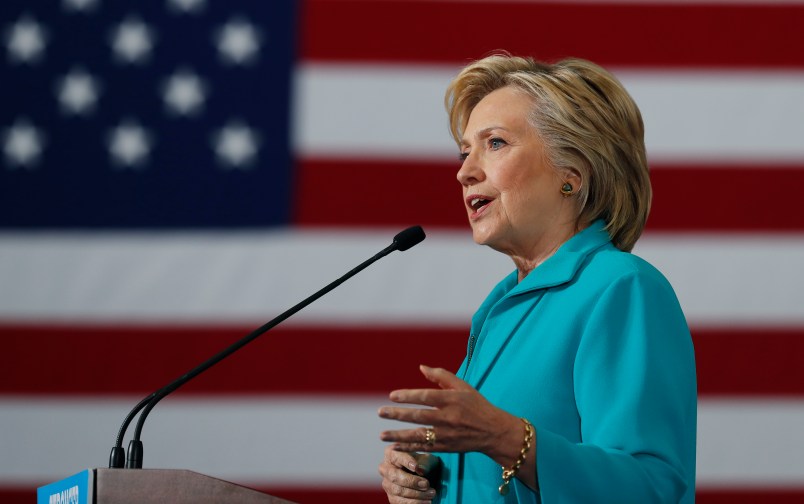This post has been updated.
A group of computer scientists believe they have evidence that suggests voting machines in Wisconsin, Michigan, and Pennsylvania have been hacked and have been urging the Hillary Clinton campaign to ask for a recount in the three key states, according to a New York Magazine report.
CNN confirmed that the experts have been in touch with John Podesta, Clinton’s campaign chair, and Marc Elias, the campaign’s general counsel.
The group includes John Bonifaz, a voting rights attorney, and J. Alex Halderman, the director of the University of Michigan Center for Computer Security and Society, according to New York Magazine.
They have not found evidence of hacking, but say that voting patterns they analyzed suggest hacking could have taken place, according to the New York Magazine report. They group of experts told the Clinton campaign that an independent review of the patterns should be conducted, according to New York Magazine.
The experts presented their findings to the Clinton campaign, telling them that Clinton received 7 percent fewer votes in counties that used electronic voting machines in Wisconsin, according to New York Magazine. The report in New York Magazine did not mention the group’s findings in Michigan or Pennsylvania.
If the results in Wisconsin and Pennsylvania were overturned and Clinton won the state of Michigan, the total of 36 electoral votes would secure Clinton the victory.
Halderman on Wednesday morning offered an explanation on why he believes states should conduct a recount by hand and said that the New York Magazine story “includes somebody else’s description of my views, incorrectly describes the reasons manually checking ballots is an essential security safeguard (and includes some incorrect numbers, to boot).”
He did not go on to correct the numbers used in the New York Magazine piece, but instead explained in a post on Medium that he believes states must check ballots manually. Halderman argued that electronic voting machines are very susceptible to hacking and cited reports that Russian hackers obtained emails from the Democratic National Committee and Joh Podesta, the Clinton campaign chair. And he wrote that checking paper ballots by hand is an “absolutely essential security safeguard,” but that not all states require it.
“Examining the physical evidence in these states — even if it finds nothing amiss — will help allay doubt and give voters justified confidence that the results are accurate,” Halderman wrote. “It will also set a precedent for routinely examining paper ballots, which will provide an important deterrent against cyberattacks on future elections. Recounting the ballots now can only lead to strengthened electoral integrity, but the window for candidates to act is closing fast.”
He did note that it’s not likely voting machines were hacked.
“Were this year’s deviations from pre-election polls the results of a cyberattack? Probably not. I believe the most likely explanation is that the polls were systematically wrong, rather than that the election was hacked. But I don’t believe that either one of these seemingly unlikely explanations is overwhelmingly more likely than the other,” he wrote.
The experts may have more evidence than the findings about patterns in Wisconsin laid out in the New York Magazine article, but data scientists on Tuesday night seemed skeptical of the findings that were made public, as the Huffington Post noted. The New York Times’ Nate Cohn indicated that the group’s findings detailed by New York Magazine were “weak.”
It’s hard to stress how weak this is. https://t.co/H3xSvrHT8y
— Nate Cohn (@Nate_Cohn) November 22, 2016
So, how much of this do you think evaporates after controlling for race and education? 100%? 90%? 80?
— Nate Cohn (@Nate_Cohn) November 22, 2016
Metro Wisconsin, where Clinton did well, uses paper; rural Wisc, where she collapsed like everywhere, is electronic. https://t.co/4aF9ooOnWe
— Nate Cohn (@Nate_Cohn) November 23, 2016
Look, maybe these researchers have a lot more than what’s in the article. But there’s a *very* easy explanation for the pattern in article
— Nate Cohn (@Nate_Cohn) November 23, 2016
Effect of paper ballots in Wisconsin goes from 7 pts, like NY article, to 0 if you control for race education, density (true w&w/o weights,) pic.twitter.com/3ZVfDa44Zn
— Nate Cohn (@Nate_Cohn) November 23, 2016
I’m just saying that there’s nothing about Trump winning WI that’s odd, given how well he did in IA/MN–where there’s a paper ballot
— Nate Cohn (@Nate_Cohn) November 23, 2016
Nate Silver also cast doubt on the findings laid out in the New York Magazine report.
To follow: some *very* quick analysis which suggests the claim here of rigged results in Wisconsin is probably BS: https://t.co/SYlE76bnmQ
— Nate Silver (@NateSilver538) November 23, 2016
Run a regression on Wisc. counties with >=50K people, and you find that Clinton improved more in counties with only paper ballots. HOWEVER: pic.twitter.com/4swuU70NaY
— Nate Silver (@NateSilver538) November 23, 2016
…the effect COMPLETELY DISAPPEARS once you control for race and education levels, the key factors in predicting vote shifts this year. pic.twitter.com/NYOINx9lEz
— Nate Silver (@NateSilver538) November 23, 2016
Maybe a more complicated analysis would reveal something, but usually bad news when a finding can’t survive a basic sanity check like this.
— Nate Silver (@NateSilver538) November 23, 2016
Nothing in Pennsylvania, either, whether or not you control for demographics. pic.twitter.com/25moBhv3Zm
— Nate Silver (@NateSilver538) November 23, 2016
And Michigan has paper ballots everywhere, so not even sure what claim is being made there. pic.twitter.com/4YKrZEhTJl
— Nate Silver (@NateSilver538) November 23, 2016







